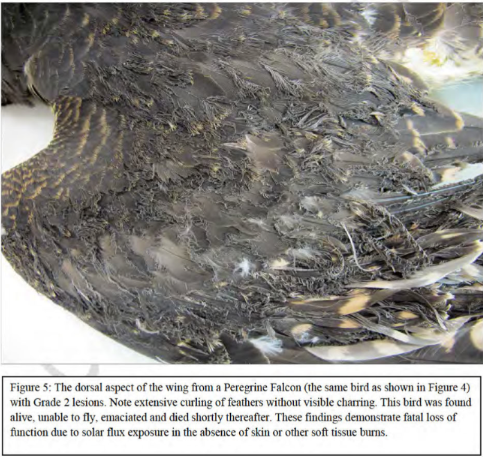Solar power generating facilities in Southern California have been dubbed “mega-traps” for their ability to attract and kill multiple species in a variety of manners including solar flux injury, also known as “singeing,” according to a report from the National Fish and Wildlife Forensics Laboratory issued in April.
“At times birds flew into the solar flux and ignited,” the authors wrote.
The toll on Southern California wildlife from three solar power plants is just beginning to be revealed:
The Ivanpah solar thermal power plant in the Southern California desert supplies enough carbon-free electricity to power 140,000 homes. For birds, bats and butterflies, though, the futuristic project is the Death Star, incinerating anything that flies through a “solar flux” field that generates temperatures of 800 degree Fahrenheit when 300,000 mirrors focus the sun on a water-filled boilers that sit on top three 459-foot towers.
“It appears Ivanpah may act as a ‘mega-trap,’ attracting insects which in turn attract insect-eating birds, which are incapacitated by solar-flux injury, thus attracting predators and creating an entire food chain vulnerable to injury and death,” concluded scientists with the National Fish and Wildlife Forensics Laboratory in a report that investigated 233 bird deaths representing 71 species at three Southern California solar power plants.
“Ivanpah employees called such immolations ‘streamers,'” said The Atlantic.
US Fish and Wildlife Service Office of Law Enforcement staff “observed an average of one streamer event every two minutes.”

From the report:
When OLE staff visited Ivanpah, we observed many streamer events. It is claimed that these events represent the combustion of loose debris or insects. Although some of the events are likely that, there were instances where the amount of smoke produced by the ignition could only be explained by a large flammable biomass such as a bird. Indeed OLE observed birds entering the solar flux and igniting, consequently becoming a streamer.
When the Ivanpah solar plant was inaugurated in earlier this year, we noted about reports of birds being killed–the “singeing” of birds in the air due to the reflective panels heating the surrounding air to such high temperatures near the California plant’s towers.
At the time, we wrote:
All power sources involve tradeoffs, but to date, wind and solar have generally avoided discussing the topic, often quickly shifting to pointing out the costs of other energy sources in defending their own environmental impacts.
Those tradeoffs included the very distinct possibility of harm to migratory birds and other wildlife.
According to the April report bats–also attracted by the insects drawn to the solar arrays–have also been found near the facilities. These include species deemed “sensitive” in California by the Bureau of Land Management.
Regulatory agencies considered those costs for Ivanpah:
Ivanpah can be seen as a success story and a cautionary tale, highlighting the inevitable trade-offs between the need for cleaner power and the loss of fragile, open land. The California Energy Commission concluded that while the solar plant would impose “significant impacts on the environment … the benefits the project would provide override those impacts.”
Those full impacts won’t even be known for another couple years, as a two-year study is completed on Ivanpah’s effect on wildlife.
The report also notes that gathering specific data about the actual temperatures involved at Ivanpah have been difficult.
“Despite repeated requests, we have been unsuccessful in obtaining technical data relating to the temperature associated with solar flux at the Ivanpah facility,” the authors wrote.
The report authors quoted a Discovery TV channel program that pegged the possible top temperature at the top of the solar tower above 3,600 degrees Fahrenheit, enough to melt steel. In order to regulate the tower at a much lower temperature, Ivanpah’s operators must turn only a percentage of heliostats at the solar receiver.
They estimated that temperatures across the solar field ranged from 200 to 900 degrees Fahrenheit.
The solar facility at Ivanpah is a darling of the Obama administration and received $1.6 billion in loan guarantees.
“This project speaks for itself. Just look at the 170,000 shining heliostat mirrors and the three towers that would dwarf the Statue of Liberty,” said Ernest Moniz, Obam’s energy secretary, as reported by The Daily Caller.







